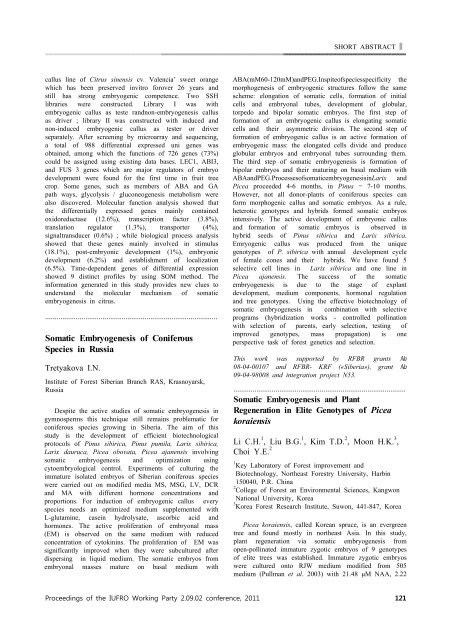Advances in Somatic embryogenesis of Trees and Its - IUFRO
Advances in Somatic embryogenesis of Trees and Its - IUFRO
Advances in Somatic embryogenesis of Trees and Its - IUFRO
Create successful ePaper yourself
Turn your PDF publications into a flip-book with our unique Google optimized e-Paper software.
SHORT ABSTRACT <br />
<br />
callus l<strong>in</strong>e <strong>of</strong> Citrus s<strong>in</strong>ensis cv. Valencia’ sweet orange<br />
which has been preserved <strong>in</strong>vitro forover 26 years <strong>and</strong><br />
still has strong embryogenic competence. Two SSH<br />
libraries were constructed. Library I was with<br />
embryogenic callus as teste r<strong>and</strong>non-<strong>embryogenesis</strong> callus<br />
as driver ; library II was constructed with <strong>in</strong>duced <strong>and</strong><br />
non-<strong>in</strong>duced embryogenic callus as tester or driver<br />
separately. After screen<strong>in</strong>g by microarray <strong>and</strong> sequenc<strong>in</strong>g,<br />
a total <strong>of</strong> 988 differential expressed uni genes was<br />
obta<strong>in</strong>ed, among which the functions <strong>of</strong> 726 genes (73%)<br />
could be assigned us<strong>in</strong>g exist<strong>in</strong>g data bases. LEC1, ABI3,<br />
<strong>and</strong> FUS 3 genes which are major regulators <strong>of</strong> embryo<br />
development were found for the first time <strong>in</strong> fruit tree<br />
crop. Some genes, such as members <strong>of</strong> ABA <strong>and</strong> GA<br />
path ways, glycolysis / gluconeogenesis metabolism were<br />
also discovered. Molecular function analysis showed that<br />
the differentially expressed genes ma<strong>in</strong>ly conta<strong>in</strong>ed<br />
oxidoreductase (12.6%), transcription factor (3.8%),<br />
translation regulator (1.3%), transporter (4%),<br />
signaltransducer (0.6%) ; while biological process analysis<br />
showed that these genes ma<strong>in</strong>ly <strong>in</strong>volved <strong>in</strong> stimulus<br />
(18.1%), post-embryonic development (1%), embryonic<br />
development (6.2%) <strong>and</strong> establishment <strong>of</strong> localization<br />
(6.5%). Time-dependent genes <strong>of</strong> differential expression<br />
showed 9 dist<strong>in</strong>ct pr<strong>of</strong>iles by us<strong>in</strong>g SOM method. The<br />
<strong>in</strong>formation generated <strong>in</strong> this study provides new clues to<br />
underst<strong>and</strong> the molecular mechanism <strong>of</strong> somatic<br />
<strong>embryogenesis</strong> <strong>in</strong> citrus.<br />
··························································································<br />
<strong>Somatic</strong> Embryogenesis <strong>of</strong> Coniferous<br />
Species <strong>in</strong> Russia<br />
Tretyakova I.N.<br />
Institute <strong>of</strong> Forest Siberian Branch RAS, Krasnoyarsk,<br />
Russia<br />
Despite the active studies <strong>of</strong> somatic <strong>embryogenesis</strong> <strong>in</strong><br />
gymnosperms this technique still rema<strong>in</strong>s problematic for<br />
coniferous species grow<strong>in</strong>g <strong>in</strong> Siberia. The aim <strong>of</strong> this<br />
study is the development <strong>of</strong> efficient biotechnological<br />
protocols <strong>of</strong> P<strong>in</strong>us sibirica, P<strong>in</strong>us pumila, Larix sibirica,<br />
Larix dauruca, Picea obovata, Picea ajanensis <strong>in</strong>volv<strong>in</strong>g<br />
somatic <strong>embryogenesis</strong> <strong>and</strong> optimization us<strong>in</strong>g<br />
cytoembryological control. Experiments <strong>of</strong> cultur<strong>in</strong>g the<br />
immature isolated embryos <strong>of</strong> Siberian coniferous species<br />
were carried out on modified media MS, MSG, LV, DCR<br />
<strong>and</strong> MA with different hormone concentrations <strong>and</strong><br />
proportions. For <strong>in</strong>duction <strong>of</strong> embryogenic callus every<br />
species needs an optimized medium supplemented with<br />
L-glutam<strong>in</strong>e, case<strong>in</strong> hydrolysate, ascorbic acid <strong>and</strong><br />
hormones. The active proliferation <strong>of</strong> embryonal mass<br />
(EM) is observed on the same medium with reduced<br />
concentration <strong>of</strong> cytok<strong>in</strong><strong>in</strong>s. The proliferation <strong>of</strong> EM was<br />
significantly improved when they were subcultured after<br />
dispers<strong>in</strong>g <strong>in</strong> liquid medium. The somatic embryos from<br />
embryonal masses mature on basal medium with<br />
ABA(mM60-120mM)<strong>and</strong>PEG.Inspite<strong>of</strong>speciesspecificity the<br />
morphogenesis <strong>of</strong> embryogenic structures follow the same<br />
scheme: elongation <strong>of</strong> somatic cells, formation <strong>of</strong> <strong>in</strong>itial<br />
cells <strong>and</strong> embryonal tubes, development <strong>of</strong> globular,<br />
torpedo <strong>and</strong> bipolar somatic embryos. The first step <strong>of</strong><br />
formation <strong>of</strong> an embryogenic callus is elongat<strong>in</strong>g somatic<br />
cells <strong>and</strong> their asymmetric division. The second step <strong>of</strong><br />
formation <strong>of</strong> embryogenic callus is an active formation <strong>of</strong><br />
embryogenic mass: the elongated cells divide <strong>and</strong> produce<br />
globular embryos <strong>and</strong> embryonal tubes surround<strong>in</strong>g them.<br />
The third step <strong>of</strong> somatic <strong>embryogenesis</strong> is formation <strong>of</strong><br />
bipolar embryos <strong>and</strong> their matur<strong>in</strong>g on basal medium with<br />
ABA<strong>and</strong>PEG.Processes<strong>of</strong>somatic<strong>embryogenesis</strong><strong>in</strong>Larix <strong>and</strong><br />
Picea proceeded 4-6 months, <strong>in</strong> P<strong>in</strong>us 7-10 months.<br />
However, not all donor-plants <strong>of</strong> coniferous species can<br />
form morphogenic callus <strong>and</strong> somatic embryos. As a rule,<br />
heterotic genotypes <strong>and</strong> hybrids formed somatic embryos<br />
<strong>in</strong>tensively. The active development <strong>of</strong> embryonic callus<br />
<strong>and</strong> formation <strong>of</strong> somatic embryos is observed <strong>in</strong><br />
hybrid seeds <strong>of</strong> P<strong>in</strong>us sibirica <strong>and</strong> Larix sibirica.<br />
Emryogenic callus was produced from the unique<br />
genotypes <strong>of</strong> P. sibirica with annual development cycle<br />
<strong>of</strong> female cones <strong>and</strong> their hybrids. We have found 5<br />
selective cell l<strong>in</strong>es <strong>in</strong> Larix sibirica <strong>and</strong> one l<strong>in</strong>e <strong>in</strong><br />
Picea ajanensis. The success <strong>of</strong> the somatic<br />
<strong>embryogenesis</strong> is due to the stage <strong>of</strong> explant<br />
development, medium components, hormonal regulation<br />
<strong>and</strong> tree genotypes. Us<strong>in</strong>g the effective biotechnology <strong>of</strong><br />
somatic <strong>embryogenesis</strong> <strong>in</strong> comb<strong>in</strong>ation with selective<br />
programs (hybridization works - controlled poll<strong>in</strong>ation<br />
with selection <strong>of</strong> parents, early selection, test<strong>in</strong>g <strong>of</strong><br />
improved genotypes, mass propagation) is one<br />
perspective task <strong>of</strong> forest genetics <strong>and</strong> selection.<br />
This work was supported by RFBR grants <br />
08-04-00107 <strong>and</strong> RFBR- KRF («Siberia»), grant <br />
09-04-98008 <strong>and</strong> <strong>in</strong>tegration project N53.<br />
··························································································<br />
<strong>Somatic</strong> Embryogenesis <strong>and</strong> Plant<br />
Regeneration <strong>in</strong> Elite Genotypes <strong>of</strong> Picea<br />
koraiensis<br />
Li C.H. 1 , Liu B.G. 1 , Kim T.D. 2 , Moon H.K. 3 ,<br />
Choi Y.E. 2<br />
1 Key Laboratory <strong>of</strong> Forest improvement <strong>and</strong><br />
Biotechnology, Northeast Forestry University, Harb<strong>in</strong><br />
150040, P.R. Ch<strong>in</strong>a<br />
2 College <strong>of</strong> Forest an Environmental Sciences, Kangwon<br />
National University, Korea<br />
3 Korea Forest Research Institute, Suwon, 441-847, Korea<br />
Picea koraiensis, called Korean spruce, is an evergreen<br />
tree <strong>and</strong> found mostly <strong>in</strong> northeast Asia. In this study,<br />
plant regeneration via somatic <strong>embryogenesis</strong> from<br />
open-poll<strong>in</strong>ated immature zygotic embryos <strong>of</strong> 9 genotypes<br />
<strong>of</strong> elite trees was established. Immature zygotic embryos<br />
were cultured onto RJW medium modified from 505<br />
medium (Pullman et al. 2003) with 21.48 M NAA, 2.22


